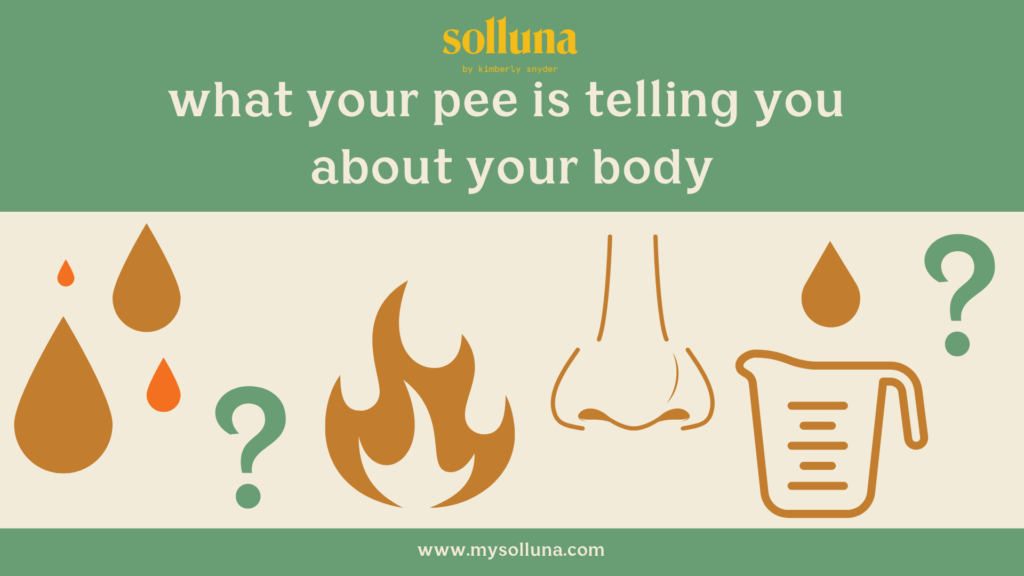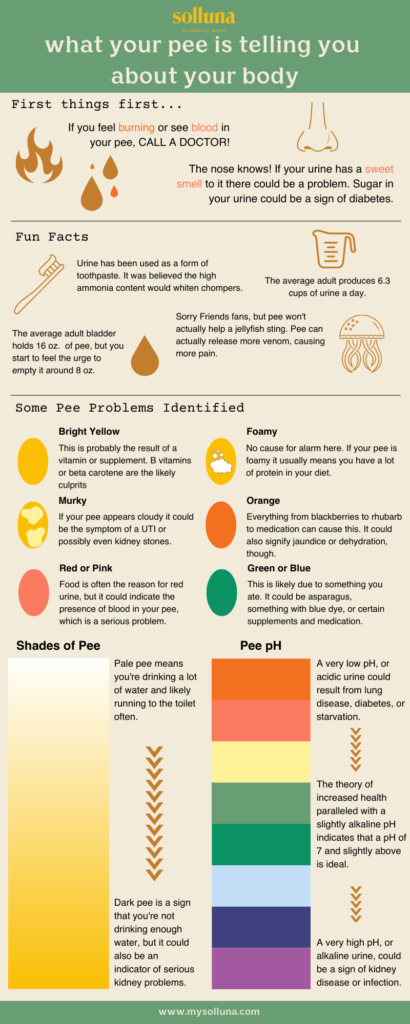
Your pee color can tell you a lot about your current state of health. You’re probably not spending a lot of time thinking about it, because it’s a common and natural daily activity. It’s just something you gotta do— especially if you drink a lot of water! But even though it sounds kind of icky, you should be keeping tabs on how your pee looks.
That’s because— just like with your poop— your pee can create a very detailed reflection of your health and habits. And it’s not just your pee color either— there’s more to your urine than you may think.
What Is Urine?
Your pee— or urine— is the excess water, electrolytes, and waste that is removed from your body. Urine is produced when your kidneys filter out that extra water and waste out of your blood and prepare it to leave your body through your urethra.
The average adult bladder holds about 16 ounces of liquid— but you normally feel the urge to empty it at around 8 ounces.
Your urine is also the earliest indicator that you could be pregnant. That’s because a hormone called human chorionic gonadotropin (hCG) is present in the urine of pregnant women. This is what traditional pregnancy tests check for because it’s not immediately obvious that hCG is present by color or smell alone.
How Often Should You Pee?
Normal urinary frequency can vary from person to person. But for most people, they’ll pee anywhere between 4 and 10 times a day— 6 to 7 times is most typical though.
How often you pee depends on a few different factors, such as:
- How much fluid you drink each day, and what kinds. Caffeine and alcohol have a diuretic effect on your body, which will make you pee more.
- Certain medications— particularly diuretics.
- Pregnancy. It’s well-known that expectant mamas have to pee a lot! That’s because fluid levels in your body increase during pregnancy, and that fluid filters out in your urine. Your growing baby pressing on your bladder can make you need to pee more too.
And while there is no true “normal” when it comes to how much you pee each day, it’s important to understand what your normal is. Because if you’re peeing more than your normal amount, then that can be a sign of another problem.
Can You Pee Too Often?
You can pee too often beyond your normal amount. Overactive bladder (OAB) is a sudden, frequent urge to urinate that affects your day-to-day life. You may also need to pee a lot at night— this is called nocturia.
Signs of an overactive bladder include:
- A sudden urge to pee that’s difficult to control
- Urgency incontinence— or an unintentional loss of urine after an urgent trip to the bathroom
- Urinating 8 or more times in 24 hours
- Needing to pee 2 or more times during the night
If you feel like you need to go too often, contact your doctor or your primary care provider. They can help you figure out what may be causing your overactive bladder and help you get the right treatment so you can get back to living your life the way you should.
So now you may be wondering— what does healthy, normal urine look like?
What Healthy Pee Looks Like
When you’re healthy and well-hydrated, your pee will either be a pale yellow color or completely clear. Clear urine is a sign that your urine is diluted with more fluid— this is a good thing, Beauty!
On the other hand, more concentrated urine is a sign that you’re dehydrated and need to get more fluids. Dark urine can also be a sign of kidney problems.
Normal urine color can vary from day to day, but as long as it stays within a certain healthy color and shade range, you’ll know that you and your urine are both healthy! Check out my infographic below to learn more.

Click to enlarge.
50 Shades of Pee— What Does This Color Urine Mean?
Not only can your urine color indicate your hydration status, but it may also be your biggest clue when something is wrong. But there’s a lot more to your pee than just the color— Its shade and pH are super important too.
You already know that pale yellow or clear urine are the signs that you’re healthy and properly hydrated— so what do other pee colors mean?
- Bright yellow urine: When you pee and it’s bright yellow you’ve likely taken a vitamin supplement. When you take multivitamin or B vitamin supplements, your body doesn’t use all of it. What your body doesn’t use is filtered out by your kidneys and shows up in your urine. This creates the bright yellow color.
- Murky urine: Murky or cloudy urine is a common symptom of a urinary tract infection (UTI), and even a kidney stone.
- Pink or red urine: Just like how eating lots of beets can turn your poop red, certain foods can also turn your pee pink or even red! Some medications can do this too. However, red urine can also be a sign of bloody urine. If you see blood in your urine, call your doctor immediately!
- Foamy urine: This is a sign that you get a lot of protein in your diet— no cause for alarm here!
- Orange urine: Orange urine can be a sign of dehydration or jaundice— a medical condition that causes yellowing of your skin or eyes. [1] It can also be caused by certain medications, as well as eating foods like blackberries and rhubarb.
- Green or blue urine: This can also be caused by certain medications and supplements. Certain foods— like asparagus— or food dye can also have this effect.
- Dark yellow urine: You are dehydrated. Drink more water!
- Dark brown urine: This can be a sign of kidney or liver problems— call your doctor immediately!
A good rule of thumb is that if you see a sudden color change or change in odor to your urine, call your doctor immediately. Remember— while it’s normal for your urine to change a little day by day, it’s not normal for it to change drastically in a short time.
What is Your Pee pH?
If you own a pool or do a lot of gardening, then you know what pH is— and how important it is to keep a balanced pH level in your pool water or soil. It’s the same with your body and your urine.
pH— short for potential of hydrogen— measures how acidic or alkaline water is. The pH scale ranges from 0 to 14— 0 is the most acidic, 14 is the most alkaline, and 7 is considered neutral. Excessively acidic/alkaline urine can also be a sign of health problems.
- A very low— or acidic— pH can be caused by lung disease, diabetes and even starvation.
- A neutral pH is what you want, and can be achieved with a healthy diet and lifestyle, and staying hydrated.
- A very high— or alkaline— pH can be a sign of kidney disease or an infection.
And while you probably won’t be using a pH test to test your pee like you would soil or pool water, a tell-tale sign that your pH is off-balance is a burning sensation while you urinate. This is not normal, and you should always see your doctor if you feel a burning sensation while you pee.
What About the Smell?
We all know about urine’s very distinctive smell. This is also normal— to a certain extent. Urine is made mostly of water, so it always has a slight smell. It won’t have as much of an odor if it’s more diluted, but more concentrated urine will have a more pronounced odor.
Different food, medication, supplements and even medical conditions can change how your pee smells. In fact, anyone who enjoys asparagus may know this all too well!
However, particularly smelly urine can be a sign of health problems. For example:
- Dehydration can cause a smell similar to ammonia in your urine. This can also indicate a UTI.
- A yeasty smell can be a sign of a yeast infection.
- Foul-smelling urine can be a sign of a sexually transmitted infection (STI).
- On the other hand, if your urine smells sweet, this is a sign that there’s sugar in your urine. This can indicate a risk of type 2 diabetes or hyperglycemia. This is because your kidneys can’t keep up with the excess glucose, and it leaves your body in your urine. It can also contribute to dehydration. [2]
When You Gotta Go…
There’s a reason your doctor asks for a urine sample when you go in for a check-up. It’s because your pee is one of the biggest reflections of your overall health. If something doesn’t look right there, then there’s something else amiss.
Pee is never something you want to ask or talk about often, but knowing what to look for can make staying healthy that much easier. This includes your pee color, the shade, and even the smell.
And remember— urinating is a natural process that everyone does. So you’re in good company, Beauty.
In health and wellness,

Citations
- “Adult Jaundice: Symptoms, Causes, Diagnosis, Treatment & Prevention.” Cleveland Clinic, my.clevelandclinic.org/health/diseases/15367-adult-jaundice.
- “Diabetes Symptoms: When Diabetes Symptoms Are a Concern.” Mayo Clinic, Mayo Foundation for Medical Education and Research, 3 June 2021, www.mayoclinic.org/diseases-conditions/diabetes/in-depth/diabetes-symptoms/art-20044248.
The post What Your Pee Color Says About Your Health appeared first on Solluna by Kimberly Snyder.
No comments:
Post a Comment